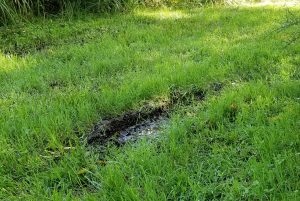WEATHER WOES have plagued us all summer. Monthly data from DEOS (the Delaware Environmental Observation System) indicates that most areas in the state are already over the average yearly rainfall which is 41 inches of rain per year in Delaware. Data from Newark, Dover, and Georgetown show above average rainfall in May of 2018, with 5 to 6 inches in Newark and Dover, but a whopping 10 inches in Georgetown that month. Planting and plant growth was delayed due to cold and wet soils. Temperatures increased in June and July, with rainfall amounts above average. Delaware averaged 47 rainy days out of 100 over the summer months. A dry period occurred in early July, but temperatures were very high during that time. Total rainfall through September 17, 2018 was 40 inches for Newark, 42 inches for Dover, and 43 inches for Georgetown (these values are above our yearly totals!). Storms have resulted in higher rainfall totals slightly to our west. For example, the Fair Hill, MD weather station reported a total of 47 inches of rain to date. With 3 months to go in 2018, soils are very saturated. Saturated soils lead to poor root development and plant health problems,  especially with newly transplanted trees and shrubs. Low lying and wet areas are prone to root rot. Trees in saturated soils with poor root systems may fall over with strong wind gusts. Remove dead or damaged trees near homes and buildings. Repair mower tracks in lawns (photo to the right). Make sure sprinklers are not running on automatic timers if ground is already saturated.
especially with newly transplanted trees and shrubs. Low lying and wet areas are prone to root rot. Trees in saturated soils with poor root systems may fall over with strong wind gusts. Remove dead or damaged trees near homes and buildings. Repair mower tracks in lawns (photo to the right). Make sure sprinklers are not running on automatic timers if ground is already saturated.
NFG 9/18/2018
Tag: poor roots
Phytophthora Resistant Plants for the Landscape
Phytophthora Resistant Plants
 Phytophthora root rot, a soil borne disease caused by a fungus-like organism, is a widespread problem which can affect many woody and herbaceous landscape plants. Azalea, holly, rhododendron, and juniper are the most frequently affected plant groups in the eastern landscape. Submit a sample including roots to the Plant Diagnostic Clinic and it can be tested for Phytophthora. An infested site should not be replanted with susceptible hosts. Increase drainage and plant a more resistant shrub or tree. The best control for Phytophthora is to avoid getting it started in the first place. Phytophthora is favored by planting susceptible species and cultivars in poorly drained soils, or by overwatering in sites with adequate drainage. Once a Phytophthora problem is established in a landscape site, the best option is to remove the affected plants and replace with resistant species. Some good choices include Clethra alnifolia (summersweet), Itea sp (sweetspire), Physocarpus opufoliius (Eastern ninebark), and Leucothoe fontanesiana. Examples suggested by extension agents in North Carolina include Nandina, Chinese holly (cultivars including 'Rotunda', 'Dwarf Burford' and 'Carissa'), liriope, Indian hawthorn, and Camellia sasanqua cultivars (Camellia japonica is highly susceptible). The rhododendron hybrids: ‘Caroline’, ‘Martha Isaacson’, ‘Professor Hugo de Vries’ and ‘Red Head’ are considered resistant. In addition, the azalea cultivars 'Formosa', 'Fred Cochran', 'Fakir' and 'Corrine Murrah' are considered highly resistant. Other resistant azalea cultivars include Rhododendron poukhanese, ‘Formosa’, ‘Fakir’, ‘Corrine Murrah’, 'Merlin', 'Hampton Beauty', 'Higasa', 'Pink Gumpo' and 'Delaware Valley'. Susceptible cultivars include 'White Gumpo', 'Hinodegiri', 'Hershey Red', 'Coral Bells', 'Pink Pearl' and 'Hino Crimson'. Susceptible cultivars are the most widely planted, due to desirable horticultural characteristics. Resistant hybrids are not immune to disease, but more tolerant. Chemical control is generally not practical for the homeowner, and involves a drench or injection by a certified applicator.
Phytophthora root rot, a soil borne disease caused by a fungus-like organism, is a widespread problem which can affect many woody and herbaceous landscape plants. Azalea, holly, rhododendron, and juniper are the most frequently affected plant groups in the eastern landscape. Submit a sample including roots to the Plant Diagnostic Clinic and it can be tested for Phytophthora. An infested site should not be replanted with susceptible hosts. Increase drainage and plant a more resistant shrub or tree. The best control for Phytophthora is to avoid getting it started in the first place. Phytophthora is favored by planting susceptible species and cultivars in poorly drained soils, or by overwatering in sites with adequate drainage. Once a Phytophthora problem is established in a landscape site, the best option is to remove the affected plants and replace with resistant species. Some good choices include Clethra alnifolia (summersweet), Itea sp (sweetspire), Physocarpus opufoliius (Eastern ninebark), and Leucothoe fontanesiana. Examples suggested by extension agents in North Carolina include Nandina, Chinese holly (cultivars including 'Rotunda', 'Dwarf Burford' and 'Carissa'), liriope, Indian hawthorn, and Camellia sasanqua cultivars (Camellia japonica is highly susceptible). The rhododendron hybrids: ‘Caroline’, ‘Martha Isaacson’, ‘Professor Hugo de Vries’ and ‘Red Head’ are considered resistant. In addition, the azalea cultivars 'Formosa', 'Fred Cochran', 'Fakir' and 'Corrine Murrah' are considered highly resistant. Other resistant azalea cultivars include Rhododendron poukhanese, ‘Formosa’, ‘Fakir’, ‘Corrine Murrah’, 'Merlin', 'Hampton Beauty', 'Higasa', 'Pink Gumpo' and 'Delaware Valley'. Susceptible cultivars include 'White Gumpo', 'Hinodegiri', 'Hershey Red', 'Coral Bells', 'Pink Pearl' and 'Hino Crimson'. Susceptible cultivars are the most widely planted, due to desirable horticultural characteristics. Resistant hybrids are not immune to disease, but more tolerant. Chemical control is generally not practical for the homeowner, and involves a drench or injection by a certified applicator.
NFG 10/2014
